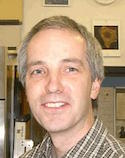Harvey McMahon conducts a highly creative research programme centred on molecular mechanisms underlying endocytosis. He has discovered different lipid-bending and curvature-sensing mechanisms, and established their generality in facilitating vesicle trafficking between different cellular compartments. The strength of his work is two-fold: first, by undertaking electron microscopic and X-ray diffraction studies, he has been able to formulate novel hypotheses regarding protein function; and second, he has developed imaginative biochemical and cell-free assays to test these structure–function predictions. His research is ground-breaking, having a profound influence on current concepts of molecular processes fundamental to all cells. He was elected a Fellow of The Royal Society in 2008.




